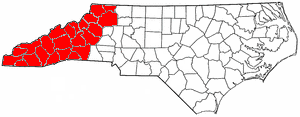|
Rich Mountain (Watauga County, North Carolina)
Rich Mountain is a mountain located in the North Carolina High Country, roughly northwest of the town of Boone. Its elevation reaches . The mountain is sometimes confused with Howard Knob, which is to its immediate east; sharing the same ridge to the west is Snakeden Mountain. The summit is private property. The summit of Rich Mountain has year-round temperatures similar to nearby Beech Mountain. While Beech Mountain stands taller, the unique environment and prevailing winds that channel through a valley just to the North of Rich, bring winter lows that compete with and are occasionally lower than Beech. The summit, and upper north face of Rich Mountain will also receive 50-90% more snow each winter than Boone. 68" of snow was recorded during the 2017/2018 winter which sported 3 different snowfalls through the end of April. The mountain generates several feeder streams to the South Fork New River (via Doe Fork) and the Watauga River The Watauga River () is a larg ... [...More Info...] [...Related Items...] OR: [Wikipedia] [Google] [Baidu] |
Watauga County, North Carolina
Watauga County ( ) from the North Carolina Collection's website at the . Retrieved 2013-01-31. is a located in the of . As of the [...More Info...] [...Related Items...] OR: [Wikipedia] [Google] [Baidu] |
North Carolina
North Carolina () is a state in the Southeastern region of the United States. The state is the 28th largest and 9th-most populous of the United States. It is bordered by Virginia to the north, the Atlantic Ocean to the east, Georgia and South Carolina to the south, and Tennessee to the west. In the 2020 census, the state had a population of 10,439,388. Raleigh is the state's capital and Charlotte is its largest city. The Charlotte metropolitan area, with a population of 2,595,027 in 2020, is the most-populous metropolitan area in North Carolina, the 21st-most populous in the United States, and the largest banking center in the nation after New York City. The Raleigh-Durham-Cary combined statistical area is the second-largest metropolitan area in the state and 32nd-most populous in the United States, with a population of 2,043,867 in 2020, and is home to the largest research park in the United States, Research Triangle Park. The earliest evidence of human occupation i ... [...More Info...] [...Related Items...] OR: [Wikipedia] [Google] [Baidu] |
Blue Ridge Mountains
The Blue Ridge Mountains are a physiographic province of the larger Appalachian Mountains range. The mountain range is located in the Eastern United States, and extends 550 miles southwest from southern Pennsylvania through Maryland, West Virginia, Virginia, North Carolina, South Carolina, Tennessee, and Georgia. This province consists of northern and southern physiographic regions, which divide near the Roanoke River gap. To the west of the Blue Ridge, between it and the bulk of the Appalachians, lies the Great Appalachian Valley, bordered on the west by the Ridge and Valley province of the Appalachian range. The Blue Ridge Mountains are known for having a bluish color when seen from a distance. Trees put the "blue" in Blue Ridge, from the isoprene released into the atmosphere. This contributes to the characteristic haze on the mountains and their perceived color. Within the Blue Ridge province are two major national parks – the Shenandoah National Park in the northern secti ... [...More Info...] [...Related Items...] OR: [Wikipedia] [Google] [Baidu] |
United States Geological Survey
The United States Geological Survey (USGS), formerly simply known as the Geological Survey, is a scientific agency of the United States government. The scientists of the USGS study the landscape of the United States, its natural resources, and the natural hazards that threaten it. The organization's work spans the disciplines of biology, geography, geology, and hydrology. The USGS is a fact-finding research organization with no regulatory responsibility. The agency was founded on March 3, 1879. The USGS is a bureau of the United States Department of the Interior; it is that department's sole scientific agency. The USGS employs approximately 8,670 people and is headquartered in Reston, Virginia. The USGS also has major offices near Lakewood, Colorado, at the Denver Federal Center, and Menlo Park, California. The current motto of the USGS, in use since August 1997, is "science for a changing world". The agency's previous slogan, adopted on the occasion of its hundredt ... [...More Info...] [...Related Items...] OR: [Wikipedia] [Google] [Baidu] |
Western North Carolina
Western North Carolina (often abbreviated as WNC) is the region of North Carolina which includes the Appalachian Mountains; it is often known geographically as the state's Mountain Region. It contains the highest mountains in the Eastern United States, with 125 peaks rising to over 5,000 feet (1,500 meters) in elevation. Mount Mitchell at 6,684 feet (2,037 meters), is the highest peak of the Appalachian Mountains and mainland eastern North America. The population of the region, as measured by the 2010 U.S. Census, is 1,473,241, which is approximately 15% of North Carolina's total population. Located east of the Tennessee state line and west of the Piedmont, Western North Carolina contains few major urban centers. Asheville, located in the region's center, is the area's largest city and most prominent commercial hub. The Foothills region of the state is loosely defined as the area along Western North Carolina's eastern boundary; this region consists of a transitional terrain of hi ... [...More Info...] [...Related Items...] OR: [Wikipedia] [Google] [Baidu] |
Boone, North Carolina
Boone is a town in and the county seat of Watauga County, North Carolina, United States. Located in the Blue Ridge Mountains of western North Carolina, Boone is the home of Appalachian State University and the headquarters for the disaster and medical relief organization Samaritan's Purse. The population was 19,092 at the 2020 census. The town is named for famous American pioneer and explorer Daniel Boone, and every summer from 1952 (except 2020 due to the COVID-19 pandemic) has hosted an outdoor amphitheatre drama, ''Horn in the West'', portraying the British settlement of the area during the American Revolutionary War and featuring the contributions of its namesake. It is the largest community and the economic hub of the seven-county region of Western North Carolina known as the High Country. History Boone took its name from the famous pioneer and explorer Daniel Boone, who on several occasions camped at a site generally agreed to be within the present city limits. Danie ... [...More Info...] [...Related Items...] OR: [Wikipedia] [Google] [Baidu] |
Howard Knob
Howard Knob (variant: Howard's Knob) is a mountain in the North Carolina High Country, located in the town of Boone. According to the US Geological Survey, the mountain's proper name is Howard Knob, but it is known to locals and tourists as Howard's Knob. Howard Knob and the surrounding area are part of the Appalachian Mountain Range. The mountain has an elevation of above sea level, and rises nearly above the town of Boone and the campus of Appalachian State University. History Howard Knob was named after Benjamin Howard, a British loyalist, contemporary of Daniel Boone, and early settler of the area. According to local legend, Howard hid from Whigs on the knoll which was to be named after him. In 1977, the Federal Energy Research and Development Administration and the Department of Energy announced that Howard Knob had been selected as the site for an experimental wind turbine, which was later built by General Electric in October 1978. The project was part of a surge in r ... [...More Info...] [...Related Items...] OR: [Wikipedia] [Google] [Baidu] |
Beech Mountain (North Carolina)
Beech Mountain is a mountain in the North Carolina High Country and wholly in the Pisgah National Forest. Its elevation reaches 5,506 feet (1,657 m) and generates feeder streams for the Elk River. Nestled on the top is the Town of Beech Mountain. Recreation Beech Mountain offers skiing, snowboarding, and tubing in the winter months. In the summer, recreation includes hiking and mountain biking. Beech Mountain Resort runs chairlifts for downhill mountain biking. Mountain Biking. One of the more interesting walking areas is the defunct theme park, which existed briefly in the 1970s; remnants of the park can be visited toda ... [...More Info...] [...Related Items...] OR: [Wikipedia] [Google] [Baidu] |
South Fork New River
The South Fork New River is a river in the U.S. state of North Carolina. It stretches from its headwaters at a spring near Blowing Rock and the Eastern Continental Divide and meanders northward along the northwestern face of the Blue Ridge Mountains through the eastern and central portions of Watauga County and then Ashe County in northwestern North Carolina, passing through the town of Boone. It joins the North Fork New River in Ashe County to form the New River. Its waters ultimately reach the Gulf of Mexico through the Kanawha River, the Ohio River, and the Mississippi River The Mississippi River is the second-longest river and chief river of the second-largest drainage system in North America, second only to the Hudson Bay drainage system. From its traditional source of Lake Itasca in northern Minnesota, it f .... Its tributaries include Winkler's Creek, Boone (Kraut) Creek and Payne Branch. Middle Fork The Middle Fork runs between the towns of Blowing Rock ... [...More Info...] [...Related Items...] OR: [Wikipedia] [Google] [Baidu] |
Watauga River
The Watauga River () is a large stream of western North Carolina and East Tennessee. It is long with its headwaters in Linville Gap to the South Fork Holston River at Boone Lake. Course The Watauga River rises from a spring near the base of Peak Mountain at Linville Gap in Avery County, North Carolina. The spring emanates from the western side of the Tennessee Valley Divide, which is, at this location, congruent with the Eastern Continental Divide. On the other side of the divides at Linville Gap are the headwaters of the Linville River in the Upper Catawba Watershed. Waters of the Linville River eventually reach the Atlantic Ocean, whereas waters of the Watauga River reach the Gulf of Mexico; hence the Eastern Continental Divide. The river then flows across Watauga County, North Carolina crossing the Tennessee state line (River Mile (RM) 55.1) at Johnson County, then into Carter County, Tennessee and ends at its confluence with the Holston River's South Fork (RM 0) ... [...More Info...] [...Related Items...] OR: [Wikipedia] [Google] [Baidu] |
Mountains Of North Carolina
A mountain is an elevated portion of the Earth's crust, generally with steep sides that show significant exposed bedrock. Although definitions vary, a mountain may differ from a plateau in having a limited summit area, and is usually higher than a hill, typically rising at least 300 metres (1,000 feet) above the surrounding land. A few mountains are isolated summits, but most occur in mountain ranges. Mountains are formed through tectonic forces, erosion, or volcanism, which act on time scales of up to tens of millions of years. Once mountain building ceases, mountains are slowly leveled through the action of weathering, through slumping and other forms of mass wasting, as well as through erosion by rivers and glaciers. High elevations on mountains produce colder climates than at sea level at similar latitude. These colder climates strongly affect the ecosystems of mountains: different elevations have different plants and animals. Because of the less hospitable terrain and ... [...More Info...] [...Related Items...] OR: [Wikipedia] [Google] [Baidu] |







